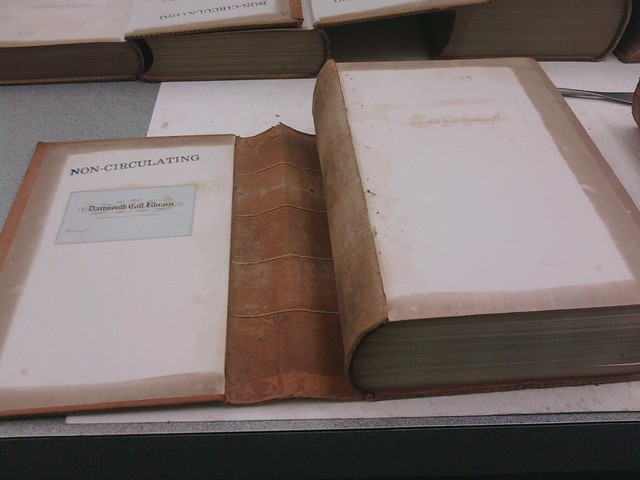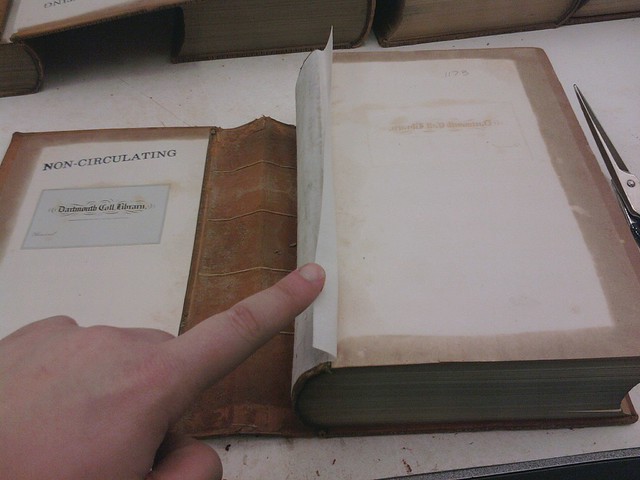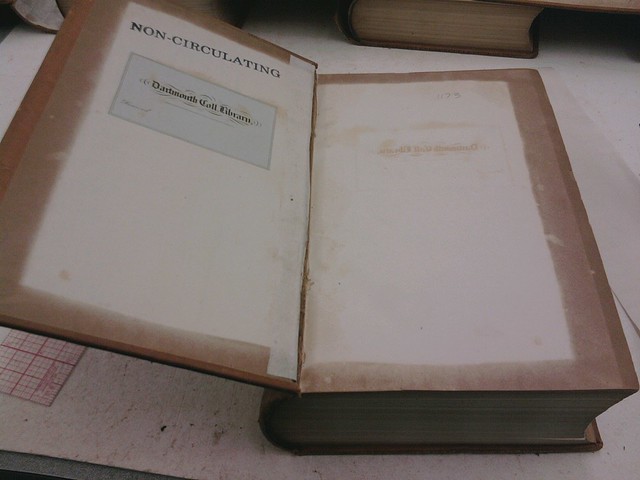Well another month has gone by, and another batch of the volumes from the U.S. Congressional Serial Set has returned from its journey to be digitized by Readex. The majority of the 65 or so volumes that return at a time only need a little sprucing because Readex takes such good care of them. But every once and a while one of these little guys needs some extra love before he's ready to hit the shelves and face the lime light that is Dartmouth College Library Patrons.
This particular volume returned to me with its back board completely fine, but its front board and spine piece detached entirely.

A pretty clean separation to be honest. The fact that it was still attached firmly to the back board was a good sign too! At face value this repair seems very run of the mill ordinary. Until we look a little closer...
The shoulder of this particular Serial Set volume is rather high and thus the front board and joint don't have a lot of room to move around. This is very counter intuitive and probably the reason why there was such a clean popped off cover. With the guidance of the lovely Collections Conservator, Deborah Howe, she showed me a very sneaky and slick way of giving this joint some space to breathe and actually function the way it ought to.
Now what is kind of amazing about this job is that sometimes it feels like I'm a surgeon in training and operating on these books. I think you'll understand when I begin to explain how we maneuvered this tight joint. First, with a paper spatula, I created a space between the leather and the board right on the edge of the joint, about an inch or so in, with enough room to slide in this light green, very condensed board.

It's a little hard to see, but that green board is actually inside the book between the leather and front board. The purpose of this is to give support near the very weak spine piece, and to offer a surface that my blade will not cut through when I make an incision.
This next part is a little scary for those of you with tender hearts about books, but I assure you I'm a trained professional and sometimes you have to crack a few eggs. With the support board in place, and another book to create a saw horse-like set up, I begin cutting very lightly approximately 1/8" from the edge of the board. Since Davey board is so thick and this board is very old and therefore quite solid, this process takes several minutes. Not to mention of course, even though the support board is there, I need to be very careful not to slice through it, damaging the spine.

You can see the pieces that have been removed already, as well as what I have left to remove. Note that the incision does not go all the way to the edge of the board. It is important not to cut to the head and tail of the book, this would create more damage.
When the incision is complete, I remove the support board and let the front board and spine relax a bit. Next I attach a Japanese Tissue liner that is the width of the spine and extends on one side about a half inch. This liner will add support to the text block as well as be a very strong anchor for the front board.
Last but not least, I flip the front board and spine back up on to the text block. Apply some glue and let it dry open so that the book has a nice tight hinge, but not too tight!
Voila! Good as new! This volume is all set and ready to return to its booky-brethren.
Written by Beth Hetland

No comments:
Post a Comment